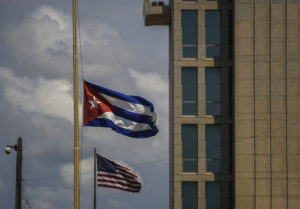Washington, D.C.—Today, the Washington Office on Latin America (WOLA) and the advocacy organization Food & Water Watch called for an end to the U.S.- backed program that sprays the Monsanto herbicide glyphosate, a probable carcinogen, on coca fields in Colombia.
Funding data gathered by Food & Water Watch shows that between 2003 and 2008, U.S. government aid programs paid as much as U.S. $79 million for Monsanto herbicides used in Colombia. Much of these costs have since been transferred to Colombia, but it is safe to estimate that the two countries have spent over US $100 million since 2003 on glyphosate.
In March, an international body of independent scientists organized by the World Health Organization (WHO) determined that the herbicide glyphosate is “probably carcinogenic to humans.” Glyphosate is the active ingredient in Monsanto’s “Round-Up” and “Round-Up Ultra,” the herbicide mixture that Colombia’s government, with U.S. support, has sprayed from aircraft over more than 4 million acres over the past 20 years.
“There is now proof that the sprayings of glyphosate represent an unacceptable risk to the public. This has critical implications for a program that has been a cornerstone of U.S. drug policy in Colombia,” said Adam Isacson, senior associate for regional security policy at WOLA. “Grounding the spray planes today is the most sensible choice. We encourage Colombia’s government to take that step, and the U.S. government to accede to it.”
On April 27, Colombia’s Health Ministry recommended that the country suspend the herbicide fumigation program. The Colombian government is to decide by May 15 whether to do so.
The glyphosate fumigation program began at the U.S. government’s behest in 1994 as a strategy to eradicate coca, the plant used to make cocaine. Colombia is the only coca-producing country that allows aerial herbicide spraying. As coca is often grown near homes and towns, and mixed with legal crops, fumigation planes routinely spray glyphosate on residential areas.
“It is bad enough that the U.S. government enriched Monsanto with tens of millions of taxpayer dollars,” said Darcey O’Callaghan, international policy director at Food & Water Watch. “When you consider that this money went toward aerial spraying of a probable carcinogen in populated areas, such corporate subsidies are unconscionable.”
“The past 20 years’ experience with coca eradication suggests that the best way to reduce coca cultivation is to bring development to the coca-growing areas,” says Isacson from WOLA. “Instead of spraying it from above, Colombia must govern its territory on the ground, with state representatives present to oversee the crop’s manual eradication and to integrate farmers into the legal economy through development assistance.”
This is the stated goal of an accord that Colombia’s government reached last year with the country’s largest guerrilla group, part of an ongoing peace negotiation process. That accord would ground the spray planes once a final accord is reached, reserving their use only for extreme situations in which manual coca eradicators find themselves under threat or attack.
“Most coca growers are poor, small-scale farmers,” said Isacson. “Aerial fumigation destroys their primary source of income, pushing them further into poverty and reinforcing their reliance on coca growing.”
WOLA has also prepared a series of graphics to accompany the "#NOFumigación" campaign (available here, or below) that show the human cost of fumigation in rural areas of Colombia. All civil society groups or media following the issue are invited to share these across their digital platforms to join in calling for an end to aerial fumigation.
###
Contact:
Kristel Mucino
WOLA Communications Director
Tel: +1 (202) 797-2171
press@wola.org
Kate Fried
Food & Water Watch Policy Communications Director
Tel: +1 (202) 683-4905
kfried@fwwatch.org






